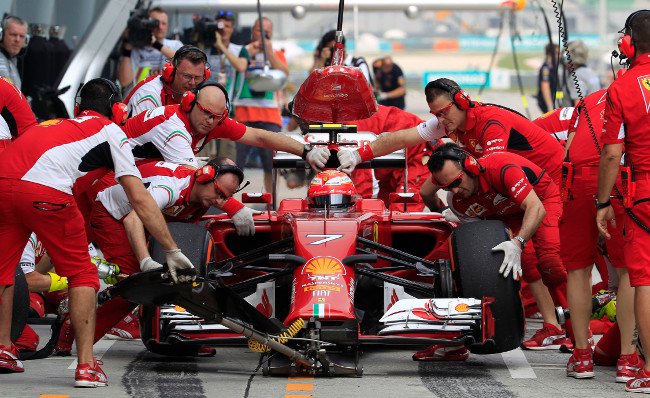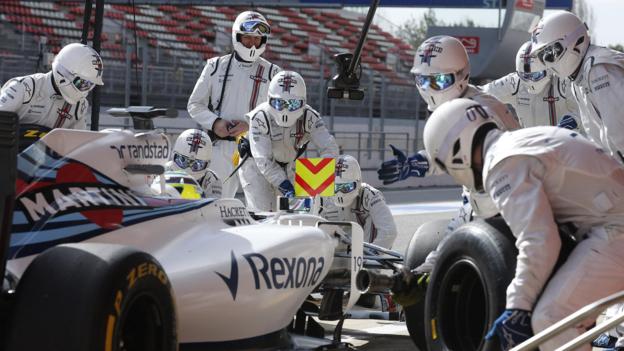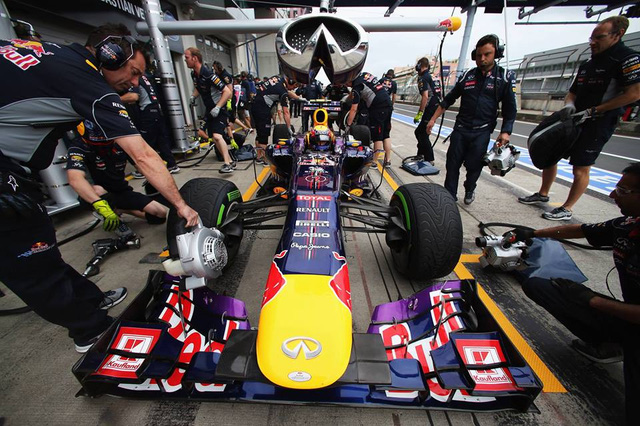Discover the mystery of a car stop in less than 2 seconds at Formula 1 track
In the recent race, a record pitstop phase was set up for only 1.89 seconds by the British F1 racing team. Let's find out, why workers can serve cars so fast?
In each race, we often only care about the drivers and the cars they control. But to be able to participate in the race and win, each fleet cannot lack pitstop.
The total length of the race is about 300km, each race car will need at least one stop at the maintenance site (pitstop) to change tires and modify the car. As soon as the driver pulled into the pitstop area, about a dozen workers rushed out, lifted the car, replaced all four wheels, wiped the glass, lowered it, and the car launched and continued the fierce race. The whole process usually takes less than 10 seconds.
In order to do that, workers need absolute precision, coordinating effortlessly to do the job in the shortest time possible because the slow time of a millisecond can also decide to win both. fleet.
 Discover the mystery of a car stop in less than 2 seconds at Formula 1 track Picture 1
Discover the mystery of a car stop in less than 2 seconds at Formula 1 track Picture 1
With the Nascar track, a team of up to 6 people needs 11 to 13 seconds to replace four tires for a pitstop. Even with long races like Le Mans 24 Now the pitstop takes longer but never takes a minute.
In the European Grand Prix race in Baku, Azerbaijan took place last June, the British F1 team Williams set a new record when making a pitstop phase at a glance, costing only 1.89 seconds. The previously set record break was 1.92 seconds of Red Bull racing team at US Grand Prix, Texas in 2013.
Video: Stopping the car for less than 2 seconds at Williams' Formula 1 track.
So, what happened to the pitstop with the cars?
For F1 racing, the car will be driven by a rider into a small stop lane, just before the waiting stand has been loaded at a speed of about 60km / h. This requires extremely high precision, riders have to stop the car extremely accurately to not hit the waiting workers. A person will lift the car with a hydraulic lift and the other two members will balance the sides of the car.
As soon as the car stopped, 12 workers would simultaneously change four wheels. Each tire will have 3 people waiting, one will remove the wheel nut with the pneumatic screw gun, the wheel is removed, the new wheel is installed and the person holding the gun is ready to tighten the belt.
 Discover the mystery of a car stop in less than 2 seconds at Formula 1 track Picture 2
Discover the mystery of a car stop in less than 2 seconds at Formula 1 track Picture 2
With the long race, the car will be filled with fuel, which can change the driver and with some vehicles, with some types of light and glass cars will be cleaned.
There are skillful mechanic teams, the car has not stopped completely, it can twist the gun valve to the nut. This, which requires absolute accuracy because of the powerful torque of these guns, only a small mistake when used can lead to very serious injuries.
When the gun leaves the wheel, the mechanic will check it carefully to make sure everything is ready, who will signal the car to join the track.
Grounding vehicle, lifters and car regulators quickly leave as soon as the pit road lights are bright, the car rushes into the track.
The speed of the pitstop has reached its peak, always hovering at the threshold of two seconds, even less than two seconds.
Why, can they achieve such a short time?
In order to achieve such a time record, the fleets all have terrible training time. Pat Symonds, chief technology officer of Williams F1, said his team made about 1700 pitstop phases each season including workshops at the weekend.
 Discover the mystery of a car stop in less than 2 seconds at Formula 1 track Picture 3
Discover the mystery of a car stop in less than 2 seconds at Formula 1 track Picture 3
Besides, the FIA (World Automobile Federation) introduced a law to ban gasoline pumping in F1 tournament from the 2010 season and it also suggested that the pitstop time reduced significantly.
The pumping of more fuel to help things happen more safely, faster, because in the past there have been a few fire accidents occurred. In 1994, at the German GP circuit, Jos Verstappen's car was engulfed in fireballs. In 2009, in Brazil GP, Kimi Räikkönen's car caught fire.
Difficult to imagine in the next years, how will the pitstop grow? Can the pitstop's time be reduced to 1.5 seconds? Let's wait, it will definitely be interesting.
You should read it
- Dizziness watching the reconstruction of the Formula 1 racing car shattered after 12 hours
- Formula 1 racing was delayed because of COVID-19
- Newspaper hunt racing with formula racing, who belongs to victory?
- How to Buy Tickets to Formula 1
- Offer F1 2015 - an appealing 1 racing game, free
- How to Get Into Racing
- Review Hotshot Racing - Simple but stylish
- Top 10 best racing games ever
- Formula 1 racing recorded with GameBoy's resolution of 0.016MP will be this interesting
- Top 20+ best racing games for Android and iOS 2018
- Download Motorsport Manager Mobile 3, a super cool racing team management game, free
- How to Become an F1 Driver
May be interested

How much wind turbines are needed to meet the power needs of our planet Earth?

Looking back on 60 years of miraculous development of hard drives today

Ultra-powerful mini flashlights can burn paper and cook food

Close-up of the transformation of the human body after death

Biscuits you eat every day often have small holes, why?

Close-up of the screen coordinates to the charm of the spring-producing robots






 How to Buy Tickets to Formula 1
How to Buy Tickets to Formula 1 TRACK CHANGES FEATURES IN WORD
TRACK CHANGES FEATURES IN WORD Instructions on how to play the game '22 Seconds' - an 'addictive' game from the Ballz game maker
Instructions on how to play the game '22 Seconds' - an 'addictive' game from the Ballz game maker The great mystery of the Solar System has just been unlocked
The great mystery of the Solar System has just been unlocked Steps to use Track Changes in Excel
Steps to use Track Changes in Excel